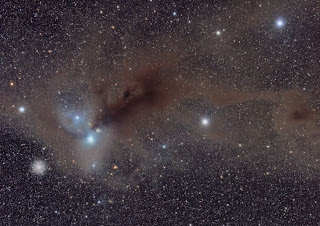It is definitely a very interesting image. One of the things that makes it so interesting is that you can actually tell that the blue star at the tip of the dark cloud was almost certainly not born out of this cloud. How can you tell?
Well, take a look at
this image by Marcus Davies of a starforming region in Corona Australis. Another, smaller image of the same part of the sky, made by Loke Kun Tan, is here.
You can see that the starforming cloud in Corona Australis looks slightly similar to the Wold Cave's Nebula and its reflection nebula van den Bergh 152. The Corona Australis dust cloud is elongated, just like the Wolf's Cave, and there is one or more bright reflection nebulae at one end of it. But here the similarity ends.
The dust cloud in Corona Australis is obviously very much more turbulent than the Wolf's Cave dust cloud. The Corona Australis dust cloud looks distorted as if it had been torn and twisted by cosmic tornadoes. It is obvious, particularly in the largest version of Marcus Davies' image, that several stars are forming in the Corona Australis dark nebula. Apart from two prominent blue reflection nebulae, there are several other smaller reflection nebulae here too.
Compare the twisted structure and the many small reflection nebulae in the Corona Australis dust cloud with the single reflection nebula and "undisturbed appearance" of the Wolf Cave's nebula. Clearly the star that has made a blue reflection nebula here wasn't born here, but has just blundered into the dust cloud by chance. According to my software, the star lighting up the reflection nebula at the tip of the Wolf's Cave is SAO 10287, a ninth magnitude star of spectral class A. The bright blue stars born from the Corona Australis dust cloud are of late spectral class B, which isn't much different from SAO 10287. No, but the stars in Corona Australis are being boisterous and kicking up a storm, and don't we all know that babies should make all kinds of noise and commotion as they are being born? SAO 10287 is no baby, and it isn't disturbing its surroundings very much as it is passing quietly by.
Ann
 In Wolf's Cave
In Wolf's Cave
